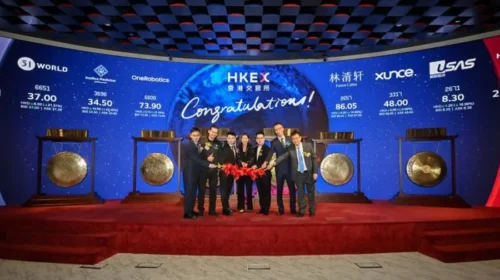The bitcoin miner outlined plans to diversify into operation of high-performance computing centers over the mid- to long-term
Key Takeaways:
- Cango reported 1 billion yuan in revenue during the second quarter, down slightly from the first quarter, as it boosted its bitcoin mining capacity by 44% in July
- The company made its first purchase of a mining facility in August, as it seeks greater efficiencies and hones its expertise in operating high-performance computing centers
By Doug Young
Bitcoin miner or high-performance computing (HPC) specialist?
The proper description for Cango Inc. (CANG.US) seems to be constantly changing as it charts a path forward after driving away from its longtime car-trading businesses late last year. The company has been building itself up as a bitcoin miner, becoming one of the world’s top two players by the end of June after completing its installation of 18 EH/s of new capacity.
In its latest quarterly report released on Thursday, Cango revealed it’s also aiming to develop its abilities to use, host and operate HPC facilities, which refers to computing facilities with the large amounts of both processing power and also electricity needed for high-performance computing. Such facilities can be used not only for bitcoin mining, but are also expected to experience exploding demand to host highly complex applications using rapidly evolving artificial intelligence (AI).
Cango made an important move in its new HPC roadmap by acquiring its first mining facility in August, as it seeks to gain expertise in the intricacies of running such high-performance computing centers. Before that, the company exclusively used an “asset-light” strategy that saw it use third-party centers to host all of its mining operations.
At the same time, Cango’s latest results show it’s starting to feel the heat of intensifying competition among bitcoin miners as more people chase the cryptocurrency now worth more than $110,000 per unit. As that happens, Cango’s cost of revenue is fast approaching its actual revenue, driving down its profitability.
“In just nine months, we’ve established ourselves as one of the largest bitcoin miners globally, supported by our asset-light strategy that enables quick scaling with minimal upfront capital,” said Paul Yu, who was named as Cango’s new CEO in July, replacing longtime chief Lin Jiayuan. “While this approach incurs higher cash costs per bitcoin, our lower depreciation expenses ensure competitive all-in costs and strong capital efficiency.”
Reflecting the ongoing change that has become part of Cango’s DNA since last November, the company laid out a roadmap for its strategy going forward, encompassing the short-, medium- and long-term. In the short-term, Cango said it will work to optimize its current 50 EH/s of mining capacity and seek to gain greater efficiencies by starting to mine using a hybrid of self-owned and third-party facilities.
Over the medium-term, it will use its newly acquired facilities to build up its HPC operating expertise, including building renewable energy storage projects that can lower operational costs. Effective energy storage is key to operating such centers efficiently, as it allows for 24-hour operations in periods when the sun isn’t shining, or during lulls in the wind. Cango disclosed it is planning to launch an HPC pilot program in the first half of next year focused on AI computing power collaboration scenarios.
“Over the long term, we are ultimately building a dynamic computing platform that intelligently balances bitcoin mining and AI workloads, all powered by our expanding energy expertise,” Yu said on the company’s earnings call.
Rising mining costs
Cango has come a long way in the last 10 months since driving away from its China car-trading business, which was suffering as the nation’s economy slows and the industry suffered from overcapacity. It began by using its large cash reserves to purchase 32 EH/s worth of bitcoin mining machines that it began operating last November, and then added an additional 18 EH/s that was operational by June. As the new capacity came onstream, the company’s bitcoin production rose 44% in July to 650.5 units from 450 units in June.
But the company is quickly discovering it isn’t the only one jumping on the bitcoin bandwagon, as a growing number of miners drives up the cost of each new coin mined. Cango said it mined 1,404.4 bitcoins during the second quarter, down about 9% from 1,541 in the previous quarter. The company’s average cost for mining each bitcoin totaled $98,636 in the latest quarter, which was roughly in line with the industry average. Excluding depreciation and amortization costs related to declining value of its mining machines, its cost-per-bitcoin was lower at $83,091.
Its second-quarter revenue totaled 1 billion yuan ($140 million), down from 1.1 billion yuan in the first quarter, again, reflecting the difficulties it faces as more people pile into bitcoin mining. But the figure should get a big boost in the third quarter with the addition of the 18 EH/s of new capacity. Cango said that addition lifts its total capacity to about 6% of the world’s total – a figure it has described as “a sweet spot for influence and efficiency.” It previously said it plans to acquire another 10 EH/s to 15 EH/s by the end of this year.
The company recorded a net loss of 2.1 billion yuan for the latest quarter, though that was nearly all due to two large non-cash items, including a 1.8 billion yuan impairment loss related to some of its mining machine acquisitions purchased using stock; and a 592 million yuan charge related to the sale of its China business. The company remained profitable on an operational basis, reporting adjusted earnings before interest, taxes, depreciation and amortization (EBITDA) of 710 million yuan.
From a strategic standpoint, a recent highlight was Cango’s purchase of a bitcoin mining facility in the U.S. state of Georgia in August for $19.5 million. It said it will use 30 MW of the facility’s 50 MW of power capacity for its own mining, while renting out the remaining 20 MW for other users.
“With this acquisition, Cango will begin developing in-house operational expertise required for managing self-owned mining sites,” it said in its August announcement disclosing the purchase. “Cango is also laying the strategic groundwork for a gradual pivot towards supplying energy for HPC applications, further expanding the long-term potential of its sites beyond bitcoin mining.”
Cango’s shares soared in the two months after initially announcing its shift to bitcoin mining, tripling in that time. But they have been relatively flat since then and are largely unchanged year-to-date. The stock currently trades at a price-to-book (P/B) ratio of 0.93, trailing the 1.23 for larger rival Mara (MARA.US), which mostly uses its own mining centers. With the bitcoin business now largely priced into Cango’s stock, investors are probably waiting for the next big catalyst, which could come if the company shows it can broaden beyond simple mining into the efficient operation of HPC computing centers.
The Bamboo Works offers a wide-ranging mix of coverage on U.S.- and Hong Kong-listed Chinese companies, including some sponsored content. For additional queries, including questions on individual articles, please contact us by clicking here
To subscribe to Bamboo Works free weekly newsletter, click here





